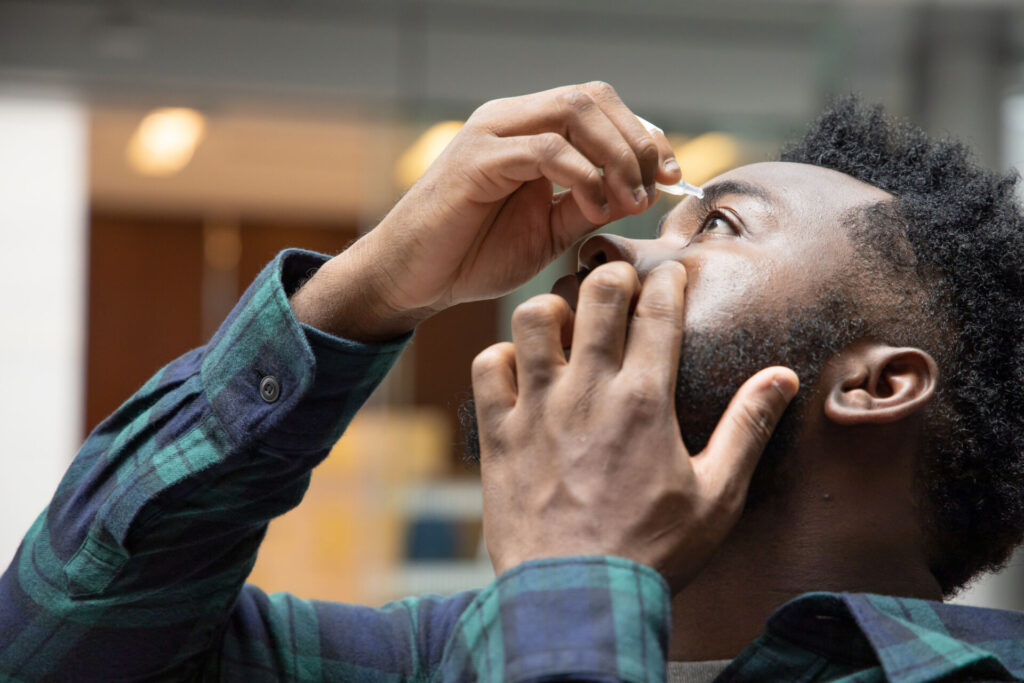Eye strain is easily one of the most common eye conditions, affecting nearly everyone at some point or another. You’ve probably experienced it yourself at the end of a long day at a computer, while driving, or when trying to do close work in inadequate lighting. The soreness and irritation around the eyes, headache, and saggy eyelids of eye strain are all-too-common complaints.
Fortunately, eye strain is seldom anything to worry about. In most cases, some environmental or lifestyle changes are enough to clear up the issue. In other cases, eye strain may mean you need new or updated corrective lenses.
In this month’s article, we’re exploring eye strain – what it is, what causes it, and how you and your trusted eye care professionals can work together to reduce your eye strain and maintain healthy vision.
What Is Eye Strain?
Eye strain is simply a condition in which your eyes and the muscles surrounding them become tired from overuse. When these tissues become tired, you can begin experiencing any of several symptoms, depending on what’s caused your eye strain:
- Tired, sore, itching, or burning sensations in your eyes
- Dry or excessively watery eyes
- Double or blurry vision
- Sensitivity to light
- Concentration and focus issues
- Headache
- Sore shoulders, neck, or back
- Heavy eyelids, or the feeling that you can’t keep your eyes open
In most cases, eye strain is a non-threatening temporary condition that can be cleared up quickly.

What Causes Eye Strain?
Several potential causes of eye strain exist. Some can be easily addressed through simple environmental or lifestyle changes, while others require corrective lenses.
Refractive Errors
Refractive errors are the most serious cause of eye strain most people ever experience, and the remedy is as simple as a pair of glasses or contacts. If you haven’t been getting regular eye exams, your vision may have deteriorated to some extent since your last visit. Refractive errors typically develop slowly, so you may not even realize that your eyes aren’t focusing correctly.
If your eyes aren’t focusing correctly, they must work much harder to see fine details of up-close objects or to make out details on distant objects. Through a thorough eye exam, your optometrist can identify your refractive error and prescribe lenses to bring the world back into focus and let your eyes rest.
Digital Eye Strain
Digital eye strain, or “computer vision syndrome,” is less serious but far more common. In this condition, the eyes are tired from staring at a computer or television screen for an extended period. Because people using digital devices tend to blink less and focus on a tiny area of their field of vision, they run a high risk of developing eye strain.
Long Periods of Focus
Another common cause of eye strain is long periods of focus. When you drive long distances, read for lengthy periods without a break, or perform any other task that requires you to maintain clear focus on something for more than a few minutes at a time, you’re likely to experience the symptoms of eye strain.
Improper Lighting
Eye strain is also commonly caused by poor lighting. If your workspace is too dim, your eyes are forced to work harder to gather enough light to create a clear image. On the other hand, if you’re trying to operate in a space that’s too bright or has too much glare, your eyes and the muscles around them will strain to maintain vision while blocking enough light to prevent eye pain. Either way, the result is the pain and irritation of eye strain.
Dry Eyes
The tears that lubricate your eyes are a crucial part of your anatomy – they protect your eyes from irritants, flush away foreign objects, and help the surface of the lens stay clear. If you’re experiencing dry eyes, either from a medical condition like dry eye syndrome or from an environmental cause like being exposed to dry, moving air, you are at a higher risk of eye strain.
How Do I Prevent Eye Strain?
There are a number of easy-to-implement changes to your environment and habits that can reduce eye strain:
- Adjust your lighting to prevent having to work in low-light or excessive-light environments.
- Take breaks from long tasks, like reading or driving. Give your eyes a chance to rest.
- Limit screen time to the greatest extent possible.
- If you have to use a computer for most of your workday, practice the 20-20-20 technique: every 20 minutes, stop and look at something 20 feet away for at least 20 seconds.
- Use artificial tear eye drops a few times a day to ensure proper lubrication and protection of your eyes.
- Wear polarized sunglasses whenever you’re outside and exposed to direct or reflected sunlight.
If none of these remedies work, you may need corrective lenses or have some other eye condition that’s causing your eye strain. If that’s the case, you should call and make an appointment with your full-service eye care center.
If you’re suffering from an uncorrected refractive error like nearsightedness, farsightedness, or astigmatism, your eye care team will be able to get you into the right corrective lenses to bring welcome relief from eye strain. If there’s another, more serious cause, your eye exam will be the starting place for finding and implementing an effective treatment.
Got More Questions About Eye Strain? Let Eyesight Associates Help!
Has eye strain got you aching for a day without pain or irritation? With eight locations around Middle Georgia and the Golden Isles, we’re always close at hand to help you maintain clear vision! Call 478-923-5872 to learn more or make an appointment.
Related Articles:
